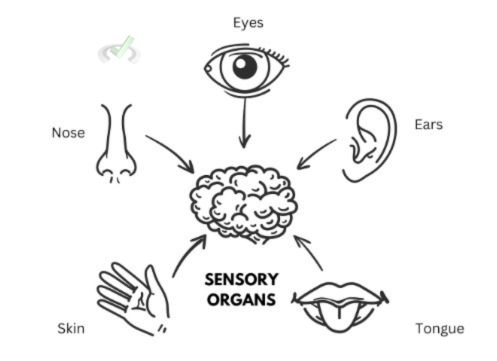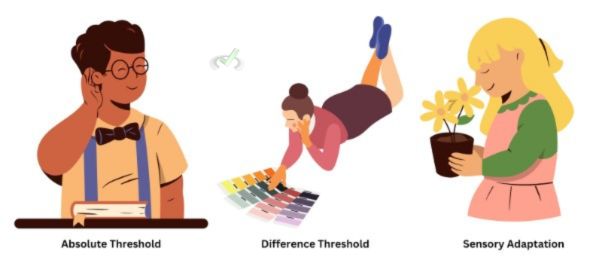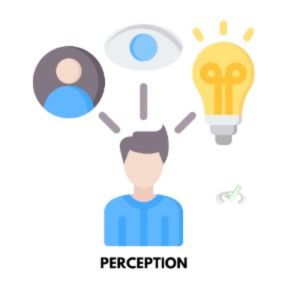Understanding how we sense and perceive the world is key in psychology. Sensation and perception help us take in information and understand our environment. This guide covers the basics and explains each concept clearly.
I. Sensation: How We Detect Information
Sensation is the process by which our sensory organs detect information from the environment. This information is then sent to the brain for interpretation.

A. Sensory Receptors
Sensory receptors are specialized cells in our sensory organs like eyes, ears, skin, nose, and tongue. They detect different types of stimuli:
- Photoreceptors in the eyes respond to light, helping us see.
- Mechanoreceptors in the skin respond to touch, pressure, and vibration.
- Chemoreceptors in the nose and tongue detect chemicals, allowing us to smell and taste.
B. Transduction
Transduction is the conversion of any physical stimuli into electrical signals. For example, photoreceptors in the eyes convert light into electrical impulses. It then travels to the brain and is processed into images.
C. Thresholds and Sensory Adaptation

- Absolute Threshold: This is the smallest amount of stimulus that can be detected. For example, the faintest sound a person can hear.
- Difference Threshold: This is the smallest difference between two stimuli that can be noticed. For example, noticing the difference between two shades of color.
- Sensory Adaptation: This happens when we get used to a constant stimulus. For example, we may not notice a smell after being in a room for a while.
II. Perception: Making Sense of Information
Perception is how we organize and interpret sensory information. It helps us understand what we see, hear, and feel.

A. Perceptual Processes
- Selection: Focusing on certain stimuli while ignoring others. For example, focusing on a teacher's voice in a noisy classroom.
- Organization: Arranging the selected information into a pattern. For instance, grouping similar objects.
- Interpretation: Understanding and giving meaning to the organized information.
B. Gestalt Principles
These principles explain how we perceive objects as whole forms rather than just a collection of parts:
- Figure-Ground: We distinguish an object (figure) from its background (ground). For example, seeing a word on a page.
- Proximity: We group objects that are close to each other. For example, seeing dots close together as a line.
- Similarity: We group similar objects. For example, grouping all red circles.
- Closure: Our mind fills in missing parts to create a complete image. For example, seeing a complete shape even when parts are missing.
C. Depth Perception
Depth perception lets us see the world in three dimensions and judge distances. It uses two types of cues:
- Binocular Cues: These require both eyes. For example, retinal disparity, where each eye sees a slightly different image, helps us judge depth.
- Monocular Cues: These require only one eye. Examples include relative size (larger objects appear closer) and linear perspective (parallel lines seem to converge in the distance).
III. Sensory and Perceptual Disorders
Sometimes, problems with sensation or perception can lead to disorders.
A. Sensory Disorders
- Blindness: The inability to see, which can result from damage to the eyes or the visual pathways in the brain.
- Deafness: The inability to hear, which can occur due to damage to the ears or auditory pathways in the brain.
B. Perceptual Disorders
- Agnosia: Difficulty recognizing objects, people, or sounds despite having normal sensory function. For instance, not recognizing a familiar face.
- Prosopagnosia: Also called face blindness, where a person cannot recognize faces, even those of close friends or family.
IV. The Brain and Perception
Different parts of the brain play roles in processing sensory information.
A. Occipital Lobe
Located at the back of the brain, the occipital lobe processes visual information and helps us interpret what we see.
B. Temporal Lobe
Found on the sides of the brain, the temporal lobe processes sounds and is involved in understanding language.
C. Parietal Lobe
The parietal lobe helps process sensory information from the body, such as touch and helps with spatial awareness.
V. Bridge/Overlap
Sensation and perception connect to many other areas in psychology and beyond.
A. Neurotransmitters and Perception
Neurotransmitters are chemicals in our body that transmit signals in the brain. They play a big role in how we perceive the world. For example, dopamine affects our perception of pleasure and pain.
B. Neuroplasticity
Neuroplasticity is the brain's ability to change and adapt over time. This is important for learning new skills and recovering from injuries. It shows how our perceptions can change with new experiences.
C. Psychological Disorders
Perceptual processes can be altered in various mental health disorders. For example, hallucinations in schizophrenia involve perceiving things that aren't there.
D. Cognitive Psychology
Cognitive psychology studies how we think, remember, and learn. It explores how our perceptions can influence our thoughts and decisions.
E. Research Methods in Psychology
Research in sensation and perception often uses techniques like brain imaging (fMRI) and behavioral experiments to study how we process sensory information.
VI. Wrap Up/Key Terms
Sensation and perception are key processes that help us detect and interpret our surroundings. Sensation involves sensing stimuli, while perception organizes and interprets this information. These processes are essential for understanding how we experience the world and connect to other psychological and neurological fields.
Key Terms
- Sensation: Detecting information through sensory organs.
- Perception: Organizing and interpreting sensory information.
- Sensory Receptors: Cells that detect stimuli (e.g., photoreceptors for light).
- Transduction: Conversion of stimuli into electrical signals.
- Thresholds: Limits of detecting stimuli (absolute and difference thresholds).
- Gestalt Principles: Ways we organize visual information (e.g., proximity, similarity).
- Depth Perception: Judging distance using binocular and monocular cues.
- Sensory Disorders: Problems like blindness and deafness.
- Perceptual Disorders: Issues like agnosia and prosopagnosia.
VII. Practice
Test your understanding with these questions:
Sample Practice Question 1
You are in a loud room but can focus on your friend’s voice. What perceptual process is this an example of?
A. Organization
B. Selection
C. Interpretation
D. Closure
Ans. B
Selection is focusing on specific stimuli while ignoring others. Here, you focus on your friend's voice and tune out other sounds.
Sample Practice Question 2
A person cannot recognize familiar faces but can identify objects. What disorder might they have?
A. Agnosia
B. Blindness
C. Prosopagnosia
D. Deafness
Ans. C
Prosopagnosia, or face blindness, affects a person's ability to recognize faces, even those of people they know well.







 To help you achieve your goal MCAT score, we take turns hosting these
To help you achieve your goal MCAT score, we take turns hosting these 





















 reviews on TrustPilot
reviews on TrustPilot